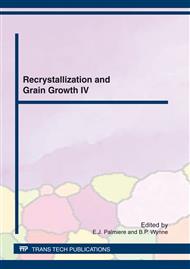p.593
p.599
p.605
p.611
p.617
p.623
p.629
p.635
p.643
The Influence of Oxide Inclusion on Austenite Grain Size and Heat Affected Zone Toughness for Low Carbon Steels
Abstract:
The low carbon steels were smelted with special oxide introduction technique and the HAZ properties has been studied with thermal simulation. The optical microscope, SEM and TEM were used to analyze the composition, size and distribution of the inclusions, and the mechanical properties after thermal simulation were also investigated. The influence of oxide inclusions on the austenite grain size was also studied. The results show that after the smelting the inclusion is complex, in the core is Ti oxides about 1-3 micron and around it is MnS. When the reheat temperature is below 1000, the size of austenite grain is the same for experimental steel and base steel. However, when the reheat temperature is over than 1100, the size of austenite grains in experimental steel is one third of that in base steels. After thermal simulation, with the t8/5 increasing the toughness of HAZ decreased. The austnite grain size also increased. The microstructure is composed of intergranular ferrite and intragranular acicular ferrite. Therefore by introducing the fine oxide inclusion to the steel the austenite grain was refined and during the phase transformation the acicular ferrite formed at inclusions at first. These two factors are the main causes to improve the toughness of heat affected zone for steels produced by oxide metallurgy technique.
Info:
Periodical:
Pages:
617-622
Citation:
Online since:
April 2012
Authors:
Price:
Сopyright:
© 2012 Trans Tech Publications Ltd. All Rights Reserved
Share:
Citation:


